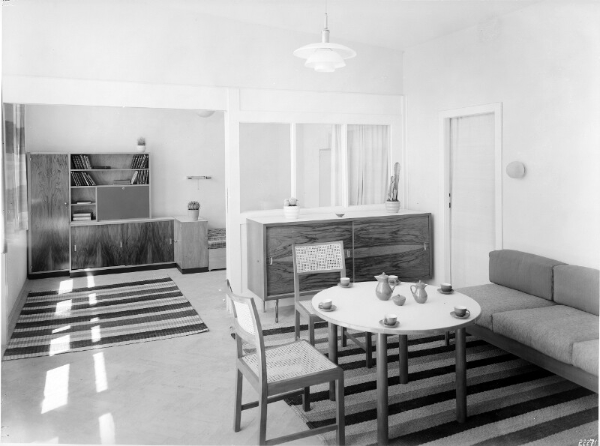
Biography
Leonie Pilewska was born on 22 February 1897 in Winniki near Lviv. Winniki is located in the former Galicia, now Ukraine, and was part of the Austro-Hungarian Empire. Leonie spent her school years in Vienna. She attended the girls’ high school at Rahlgasse 4 in 1060 Vienna and passed her A-Levels on 30 May 1915.
Since 1915, Leonie Pilewska had repeatedly applied to the rectorate of the Technische Hochschule Wien (Technical University Vienna) for admission as a regular student – at that time, however, for the Maschinenbauschule (mechanical engineering school). In October 1915, she was denied enrolment, citing the existing legal situation. Women were only admitted to certain teaching subjects as non-degree students. Admission for women to study as regular students at technical universities did not take place until 7 April 1919.
In October 1915, she still took Descriptive Geometry as a non-degree student and one year later she again turned to the Rectorate and a little later again directly to the Ministry of Education with the request for admission, now as an non-degree student for technical lectures – but without success.
Leonie Pilewska then tried a different path. In 1917 she applied to the Deutsche Technische Hochschule (German Technical University) in Brno. There she was admitted as a non-degree student in mathematics, provided that she would study to become a teacher. However, this was out of the question for her.
In the summer semester of 1917, she was able to attend lectures in Mechanics 1, Mechanical Technology and Machine Drawing at the Technische Hochschule Wien as a guest student. At the same time, she attended the lectures Chemische Übungen für Anfänger (Chemical Exercises for Beginners) and Grundzüge der botanischen Systematik (Basics of Botanical Systematics) at the Faculty of Philosophy of the University of Vienna.
Finally, in the fall of the same year, she transferred to the Technische Universität Darmstadt (Technical University in Darmstadt), where she successfully enrolled as a regular student in the mechanical engineering program. A year later, she switched to structural engineering/architecture and passed the Diplom-Hauptprüfung (main diploma examination) in December 1922.
After graduating, she worked in residential construction in Darmstadt and Berlin and was able to contribute to villa buildings under the influence of Mendelsohn and Gropius. From 1926 to 1928 she lived in Moscow and was active in building cooperatives in the construction of workmen’s homes.
After her return from Russia, on 25 November 1928, she took part at the founding congress of the Bundes der Freunde der Sowjetunion (League of Friends of the Soviet Union) in the ballroom of the Association of Engineers and Architects in Vienna. She spoke about the building activities in the new Russia and wrote several articles on the subject, which were published in renowned journals. For example, in the journal edited by Ernst May: Das neue Frankfurt as well as in the journal of the Deutscher Werkbund Die Form. As a writing architect, she reported on the Soviet building scene and critically dealt with the emerging contradictions in Soviet society.
She participated in two CIAM congresses in the following years:
1929 at CIAM II in Frankfurt am Main: ‘Die Wohnung für das Existenzminimum’ (‘Housing for the Subsistence Minimum)’ and 1930 at CIAM III in Brussels: ‘Rationelle Bebauungsweisen’ (‘Rational Construction Methods’).
During a longer stay abroad, in 1930 in Arosa, Switzerland, she had the opportunity to work on various building projects (villas, sanatoriums and hotel kitchens). Here it was above all the influence of the Dutch architect J. J. P. Oud, whom she particularly admired, that helped her to form her modern style. This was characterised by unpretentious simplicity as well as practicality.
Her most famous traces in Vienna are to be found in the Vienna Werkbundsiedlung, where this reduced style and her design, characterized by clear forms, can be found in the furnishings of Hugo Häring’s house number 1.
As a Jew and convinced Social Democrat, Leonie Pilewski fled from Vienna via Switzerland to Sweden on 12 March 1938 to escape the Gestapo and settled in Stockholm. In 1940 she married the Swede Olof Karlsson. As far as is known, she was in poor health and devoted herself to painting in the following years. Under the name Leonie Pilewski-Karlsson she participated in several exhibitions. Her art shows still life, flowers and landscapes in oil, pastel, gouache, or watercolour.
Works (selection)
1931 Werkbundsiedlung 1130 Vienna, house no. 1: living space, furnishings
Publications (selection)
1928 Leonie Pilewski, Moderne Bauten in Moskau, in: Das neue Frankfurt, 2, p.86-90
1929 Leonie Pilewski, Wohnungsbau in Russland, in: Das neue Frankfurt, 3, p.31-34
1930 Leonie Pilewski, Neue Bauaufgaben in der Sowjet-Union, in: Die Form, issue 9, p.231-237
1930 Leonie Pilewski, Die Wohnungspolitik in der Sowjetunion, in: Die Wohnungsreform, 1, issue 5, p.4-7
1931 Leonie Pilewski, Neuer Wohnungsbau in der Sowjet-Union, in: Die Form, issue 3, p.98-106
1932 Leonie Pilewski, Der Park der Kultur und Erholung in Moskau, in: Die neue Stadt, 12, p.7-8
1933 Leonie Pilewski, Was hat die moderne Architektin der modernen Frau zu sagen, in: Arbeiter-Zeitung, 17.01.1933, p.6
Sources
Juliane Mikoletzky, Ute Georgeacopol-Winischhofer, Margit Pohl: „Dem Zuge der Zeit entsprechend …“ Zur Geschichte des Frauenstudiums in Österreich am Beispiel der Technischen Universität Wien, WUV-Universitätsverlag Wien, 1997.
Sabine Plakolm-Forsthuber: Darstellungen und Selbstdarstellungen, Publikationen der ersten Architektinnen im Roten Wien in: Harald R. Stühlinger (Hg.): Rotes Wien Publiziert, Architektur in Medien und Kampagnen, Wien, Berlin 2020, p.64
AT-UAW, Phil. Nat. Frauen, WS 1915/16, fol. 49 und AT_UAW, Phil. Nat. Frauen, wS 1916/17, fol. 76
AT-ÖStA Österreichisches Staatsarchiv, Archiv der Republik, E-uReang AHF K Karlsson Leonie
Architektin Dipl. Ing. Leonie Pilewski in Österreichische Kunst, 1933, issue 4, p. 30
Kongress des öesterreichischen Bundes der Freunde der Sowjetunion, in: Die rote Fahne 24.11.1928 p.3
Kundgebung für den Abrüstungsgedanken in: Der Tag, 27.11.1928, p.7
Photo passport: ÖStA, Archiv der Republik
Photo living room: ÖNB, http://data.onb.ac.at/rec/baa14700848 ÖNB/Wien Bildarchiv 423001-D
Text: Carmen Trifina
Februar 2022

